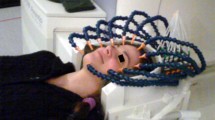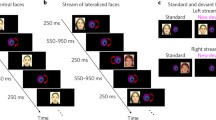Abstract
The paper addresses problems of the development of visual spatial functions of the right hemisphere of the human brain in ontogeny and phylogeny. The problem is being treated as an interdisciplinary one, and its potential as evidence of significant changes in cerebral asymmetry in historical times is discussed. Data from evolutionary physiology, anthropology, neuropsychology, and visual art history beginning with the Paleolithic are considered together. The authors pay special attention to such functions as perception of volume of objects and depth of three-dimensional visual scenery as well as perception of the face and emotional expressiveness both in clinical pathology and in normal subjects at different stages of ontogeny, and the appearance of these features in the history of art.
Similar content being viewed by others
REFERENCES
Balonov, L.Y., Deglin, V.L., Kaufman, D.A., and Nikolaenko, N.N., Functional Asymmetry of the Animal Brain, Neurosci. Behav. Physiol., 1984, vol. 14, pp. 427–437.
Nikolaenko, N.N. and Deglin, V.L., Space Semiotics and Functional Asymmetry of the Brain, Struktura dialoga kak printsip raboty semioticheskogo mekhanizma. Trudy po znakovym sistemam, Uchenye Zapiski Tartusskogo gos. Univ. (Dialogue Structure as a Work Principle of Semiotic Mechanism, Proc. on Sign Systems, Scientific Papers of Tartu State University), Tartu, 1984, vol. 17, no. 641, pp. 48–67.
Nikolaenko, N.N., Brain Pictures, Osaka, Kansai University, 1998.
Deglin, V.L., Ivashina, G.G., and Nikolaenko, N.N., Role of Dominant and Non-Dominant Hemispheres in Space Representation, Neiropsikhologicheskii analiz funktsional'noi asimmetrii mozga (Neuropsychological Analysis of Functional Brain Asymmetry), Khomskaya, E.D., Ed., Moscow, 1986, pp. 58–70.
Egorov, A.Y. and Nikolaenko, N.N., Functional Brain Asymmetry and Visuo-Spatial Perception in Mania, Depression and under Psychotropic Medication, Biol. Psychiat., 1992, vol. 32, pp. 399–410.
Nikolaenko, N.N., Egorov, A.Y., and Freiman, E.A., Representation Activity of the Right and Left Hemispheres of the Brain, Behav. Neurol., 1997, vol. 10, pp. 49–59.
Nikolaenko, N.N., Tvorchestvo i mozg (Creativity and Brain), St. Petersburg, 2001.
Balonov, L.Y., Barkan, D.V., Deglin, V.L., and Nikolaenko, N.N., Unilateral'nyi elektrosudorozhnyi pripadok (Unilateral Electroconvulsive Attack), Leningrad: Nauka, 1979.
Deglin, V.L., Lebedev, B.A., Nikolaenko, N.N., and Isakov, M.P., Unilateral'naya elektrosudorozhnyaya terapiya (Unilateral Electroconvulsive Therapy), Methodical Recommendations, Leningrad, 1986.
Rauschenbach, B.V., Prostranstvennye postroeniya v zhivopisi (Space Constructing in Pictorial Art), Moscow, 1980.
Menshutkin, V.V. and Nikolaenko, N.N., Role of the Right Cerebral Hemisphere in Providing Constancy of Object Size Perception, Fiziol. Chelov., 1987, vol. 13, pp. 324–326.
Iaccino, J.F., Left Brain-Right Brain Differences, Hillsdale, N.J.: Lawrence Erlbaum, 1993, pp. 31–32.
Bogen, J.E., The Dual Brain: Some Historical and Methodological Aspects, Specialization in Humans, Benson, D.F. and Zaidel, E., Eds., New York: Guilford, 1985, pp. 27–43.
Cummings, J.L., Hemispheric Asymmetries in Visual Perceptual and Visual-Spatial Function, The Dual Brain, Benson, D.F. and Zaidel, E., Eds., New York: Guilford, 1985, pp. 27–43.
Ellis, H.D., Introduction: Processes Underlying Face Recognition, The Neuropsychology of Face Perception and Facial Expression, Bruyer, R., Ed., Hillsdale, N.J.: Lawrence Erlbaum, 1986, pp. 1–27.
Geschwind, N., Specializations of the Human Brain, The Emergence of Language, Readings From Scientific American Magazine, Yang, W.S-Y., Ed., 1989, p. 77.
Rhodes, G., Lateralized Processes in Face Recognition, British J. Psychol., 1985, vol. 76, pp. 249–271.
Cutting, J., The Right Cerebral Hemisphere and Psychiatric Disorders, Oxford, England: Oxford U.P., 1990, pp. 178–179.
Blanc-Garin, J., Faces and Non-Faces in Prosopagnostic Patients, Aspects of Face Processing, Ellis, H.D., Ed., Dordrecht: Martinus Nijhoff, 1986, pp. 273–278.
Bornstein, B., Stroka, M., and Munitz, H., Prosopagnosia with Animal Face Agnosia, Cortex, 1969, vol. 5, pp. 164–169.
McNeil, J.E. and Warrington, E.K., Prosopagnosia: A Face-Specific Disorder, Quart. J. Experim. Psychol., 1993, vol. 46, pp. 1–10.
Johnson, M.H. and Morton, J., Biology and Cognitive Development: The Case of Face Recognition, Cambridge, Mass.: Blackwell B, 1991, pp. 31–32.
Coren, C.C., Sarty, M., and Wu, P.W.K., Visual Following and Pattern Discrimination of Face-Like Stimuli by New Born Infants, Pediatrics, 1975, vol. 56, pp. 544–554.
Ekman, P., Friesen, W.V., and Ellsworth, P., Research Foundations, Emotion in the Human Face, Ekman, P., Ed., Cambridge: Cambridge U.P., 1982, pp. 1–6.
Mehrabian, A., Nonverbal Communication, Chicago: Aldine-Therton, 1972, pp. 84–103.
Shlain, W., Art and Physics, New York: Morrow W., 1991, p. 396.
Nikolaenko, N.N., The Role of the Right and Left Brain Hemispheres in Recognition of Faces, Zh. Evol. Biokhim. Fiziol., 1999, vol. 35, pp. 522–532.
Ge, C. and Mens, L., Primary Stages in Single-Glance Face Recognition: Expression and Identity, Aspects of Face Processing, Ellis, H.D., Ed., Dordrecht: Martinus Nijhoff, 1986, pp. 356–362.
Brener, M., Faces. The Changing Look of Humankind, Lanham; New York; Oxford: Univ. Press of America, 2000.
Honour, H. and Fleming, J., The Visual Arts: A History, 2nd Ed., Englewood Cliffs, N.J.: Prentice-Hall, 1982, p. 17.
Garlake, P.S., Archetypes and Attributes: Rock Paintings in Zimbabwe, World Archaeol., 1994, vol. 25, p. 3.
Pontius, A.A., Links between Literacy Skills and Accurate Spatial Relations in Representations of the Face: Comparison of Preschoolers, School Children, Dyslexics, and Mentally Retarded, Percept. Motor Skills, 1983, vol. 57, pp. 659–666.
Habib, M., Visual Hypoemotionality and Prosopagnosia Associated with Right Temporal Lobe Isolation, Neuropsychol., 1986, vol. 24, pp. 577–582.
Ucko, P.J. and Rosenfeld, A., Palaeolithic Cave Art, New York: McGraw-Hill, 1967, pp. 228–229.
Hufschmidt, H.-J., Das Rechts-Links-Profil im kulturhistorischen Langsschnitt, Arch. Psychiat. Nervenkrankenh., 1980, vol. 229, pp. 17–43.
Springer, S. and Deutsch, G., Left Brain, Right Brain, New York: W.H. Freeman, 1985, p. 20.
Kinsbourne, M., Eye and Head Turning Indicates Cerebral Lateralization, Science, 1972, vol. 176, pp. 539–541.
Nikolaenko, N.N. and Egorov, A.Y., The Role of the Right and Left Cerebral Hemispheres in Space Perception: Communication I. Object Perception and Reflection in the Frontal Plane, Fiziolog. Chelov., 1998, vol. 24, pp. 54–64.
Kerckhove, D.D., Critical Brain Processes Involved in Deciphering the Greek Alphabet, The Alphabet and the Brain, Kerckhove, D.D. and Lumsden, C.J., Eds., Berlin: Springer, 1988, pp. 401–421.
Bazin, G., A Concise History of Art, London: Thames and Hudson, 1964, pp. 70–71.
Lumsden, C.J. and Wilson, E.O., Genes, Mind and Culture, Cambridge: Harvard Univ., 1981, pp. 5–6.
Wolpoff, M.H., The Place of Neanderthals in Human Evolution, The Emergence of Modern Humans, Trinkhaus, E., Ed., Cambridge: Cambridge U.P., 1989, p. 136.
Chernigovskaya, T.V. and Deglin, V.L., Metaphoric and Syllogistic Thinking as a Manifestation of the Functional Brain Asymmetry, Semiotika prostranstva i prostranstvo semiotiki. Trudy po znakovym sistemam. Uchenye Zapiski Tartusskogo gos. Univ. (Semiotics of Space and Space of Semiotics. Proc. on Sign Systems, Scientific Papers of Tartu State University), Tartu, 1986, vol. 19, no. 720, pp. 68–84.
Author information
Authors and Affiliations
Rights and permissions
About this article
Cite this article
Nikolaenko, N.N., Brener, M. Functional Cerebral Asymmetry and Its Possible Evolution in Historical Times. Journal of Evolutionary Biochemistry and Physiology 39, 491–501 (2003). https://doi.org/10.1023/B:JOEY.0000010248.13780.d4
Issue Date:
DOI: https://doi.org/10.1023/B:JOEY.0000010248.13780.d4




